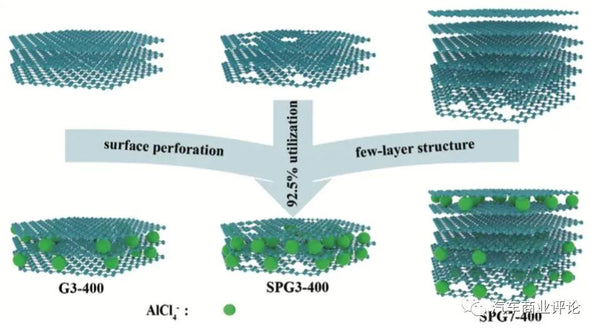With the invention of a nanotechnology-driven battery in Australia, concerns about electric vehicle range anxiety, recycling and fast charging may all become history.
Graphene aluminum-ion batteries from the Brisbane Graphene Manufacturing Group (GMG) are said to charge 60 times faster than the best lithium-ion batteries, and the energy storage capacity is 3 times that of the best aluminum-based batteries .
They are also safer, have no ampere limit that can cause spontaneous overheating, are more sustainable, and are easier to recycle, thanks to their stable substrate. Tests also show that the service life of this coin battery is three times that of lithium-ion batteries.
GMG plans to bring graphene aluminum ion coin batteries to the market at the end of 2021 or early 2022, and will launch car pouch batteries in early 2024.
Graphene aluminum ion technology
The battery is based on the breakthrough technology of the Australian Institute of Bioengineering and Nanotechnology at the University of Queensland, which uses nanotechnology to inject aluminum atoms into the cavities of the graphene plane.

Tested by the peer-reviewed expert publication "Advanced Functional Materials", the battery has "excellent high-rate performance (149 mAh g-1 at 5A g-1), surpassing all previously reported cathode materials for aluminum-ion batteries ".
GMG general manager Craig Nicol (Craig Nicol) said that although the company's batteries are not the only graphene aluminum-ion batteries being developed, they are undoubtedly the strongest, most reliable, and fastest charging batteries.
"It charges very fast. It's basically a super capacitor," Nicol said. "It can charge a coin cell in less than 10 seconds."
It is said that this new type of battery can provide greater power density than current lithium-ion batteries, and there are no cooling, heating or rare earth problems.
"There is no temperature problem so far. 20% of the energy in the lithium-ion battery pack (in the car) needs to be used for cooling. It is very likely that our battery does not need to be cooled or heated at all." Nicol said.
"Currently in testing, it won’t overheat and it works well below zero. They don’t require cooling or heating circuits,
Nicol said that new battery technology can also be industrialized to adapt to current lithium-ion housings, such as the Volkswagen Group’s MEB architecture, thereby avoiding the problems of automotive industry architectures, which are often used for up to 20 years.
Nicol said: "Our battery will have the same shape and voltage as the current lithium-ion battery, or we can turn to any shape we need."
"This is a direct substitute, charging very fast, basically like a supercapacitor. Some lithium-ion batteries cannot exceed 1.5-2 amps, otherwise the battery will explode, but our technology has no theoretical limit. "
Aluminum ion batteries used in cars
Aluminum ion batteries are a hot spot for development, especially for automobiles.
Only the most recent projects include the cooperation between Dalian University of Technology and the University of Nebraska, Cornell University, Clemson University, University of Maryland, Stanford University, Zhejiang University Department of Polymer Science and the European Alliance of Aion Industries Cooperation.
The difference is highly technical, but the GMG battery uses graphene produced by its proprietary plasma process instead of a traditional graphite source, and its energy density is three times that of Stanford’s second-best battery.
Stanford University's natural graphite aluminum ion technology provides two energy densities of 68.7Wh/kg and 41.2Wh/kg, while its graphite foam is as high as 3000Wh/kg.
The battery that GMG cooperates with the University of Queensland will increase these figures to between 150-160Wh/kg and 7000Wh/kg.
"Researchers at the University of Queensland have discovered a way to make holes in graphene and store aluminum atoms more tightly in the holes. If we drill holes in graphene, the atoms will stick to the graphene, the density of graphene Will greatly increase."
The peer-reviewed publication "Advanced Functional Materials" found that the surface-perforated three-layer graphene (SPG3-400) has "a large number of in-plane mesopores (≈2.3nm) and an extremely low oxygen-to-carbon ratio (O/C) of 2.54%. , Showing excellent electrochemical performance."
"This SPG3-400 material exhibits extraordinary reversible capacity (197mAhg-1 at 2Ag-1) and excellent high-rate performance." The report concluded.
Aluminum ion technology advantages
Compared with the excellent lithium-ion battery technology currently used in almost every electric vehicle, aluminum-ion technology has inherent advantages.
When the battery is charged, aluminum ions return to the negative electrode, and each ion can exchange three electrons, while the speed limit of lithium ions is only one electron.
The use of aluminum ion batteries also has huge geopolitical, cost, environmental and recycling advantages, because they hardly use any foreign materials. "It is basically aluminum foil, aluminum chloride (a precursor of aluminum that can be recycled), ionic liquid and urea." Nicol said.
"90% of the world's lithium production and purchases still go through China, and 10% go through Chile. Australia has the aluminum we need, and they can be safely produced in the first world." He said.
Another benefit of aluminum ion batteries is cost savings. The price of lithium has risen from US$1,460 per ton in 2005 to US$13,000 per ton this week, while the price of aluminum has risen slightly from US$1,730 per ton to US$2078 during the same period.
Another advantage is that the GMG graphene aluminum ion battery does not use copper, and the cost of copper is about $8,470 per ton.
Although GMG is open to manufacturing agreements, its preferred plan is to "implement" the technology as much as possible, starting with 10gW to 50gW power plants, even though Australia may not be a reasonable first choice for manufacturing facilities.
In Brisbane, GMG is not the only company pushing battery solutions to the world. PPK Group established a joint venture with Deakin University to develop lithium-sulfur batteries. The Vecco Group has confirmed an agreement with Shanghai Electric to build a vanadium battery production plant for commercial energy storage in Brisbane.

